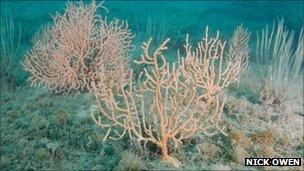Marine Conservation Zone hope for six Dorset sites
- Published

Pink seafans, a protected species of soft coral, are at risk along Chesil Beach from trawler equipment
Six marine sites in Dorset have been named as potential Marine Conservation Zones (MCZ).
Chesil Beach, Poole Rocks, Studland Bay, an area south of Portland, an area south of Weymouth Bay and a section of Kimmeridge Bay have been selected.
The Dorset Wildlife Trust says these areas are unique because of their diverse habitats, including Studland's seagrass beds and Chesil's reef ledges.
A total of 100 planned sites have been unveiled across the UK.
Chesil's reef ledges - known as Stennis Ledges - extend north east to south west along the 29km (18 mile) stretch of Chesil's shingle beach.
Kathryn Dawson, marine survey and data officer for Dorset Wildlife Trust, said: "We are particularly pleased to see Stennis Ledges on the list.
"It provides a rich, bio-diverse habitat for wildlife such as native oysters, sponges and pink seafans."
'Negative impact'
Pink seafans, a protected species of soft coral, are at risk in the area from trawler equipment, the trust said.
Mrs Dawson said: "Pink seafans are slow growing and are very sensitive to physical disturbance.
"Anything which dredges the area has a negative impact.
"Recent surveys have shown a lot of skeletons have washed up on the beaches from Weymouth to Lyme Regis."
The largest proposed MCZ for Dorset is an area named South Dorset, which has an area of 192.6 sq km (74.3 sq miles) and is 21km (13 miles) off Weymouth Bay.
The smallest is a 0.09 sq km (0.03 sq mile) zone chosen at Kimmeridge Bay.
Mrs Dawson said: "We had hoped for something more substantial at Kimmeridge.
"It's an area known for its peacock tail seaweed, rare stalked jellyfish and the protected paludinella sea snail."
Tom Hooper, from Finding Sanctuary which has chosen the proposed MCZs, said every site had been selected subject to an "enormous amount" of scrutiny and discussion.
- Published8 September 2011
- Published8 September 2011
- Published7 September 2011
- Published1 September 2011
- Published4 August 2011
- Published24 May 2011